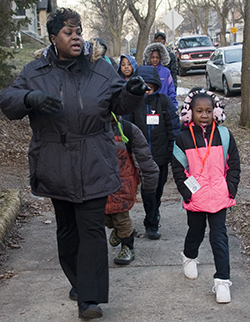Tyonna Jackson ordinarily enjoys the four-block walk to school, but there was one brutal day this winter when riding a bus would have come in handy.
Still, she braved the elements because she had the next best thing to a real vehicle — a group of students and adults to walk with.

How to Start a Walking School Bus
Source: National Center for Safe Routes to School, University of North Carolina Highway Safety Research Center |
The Campus Elementary student is part of the Neland and Thomas Walking School Bus, a group of about a dozen students who band together every day at 7:30 a.m. to walk to their nearby Grand Rapids school.
While it’s not a real bus, the students say they enjoy the exercise, camaraderie and safety in numbers provided by the adult-led chain of children. That’s even if Mother Nature doesn’t cooperate, said Tyonna, who walks with her sister, Keonna, and grandmother, Cynthia.
Tyonna said even bad weather isn’t enough to wreck the students’ daily routine. The students prepare for frigid temperatures, blowing snow and at least one typically busy street to make the short trek to school. The kids take it all in stride, Tyonna said.
“There was one day when we had a lot of blowing snow and cold, but I still walked because I wasn’t going to let the other kids down,” she said.
Tyonna and her schoolmates aren’t the only ones forming virtual buses to school. The Safe Routes to School National Partnership includes more than 800 organizations encouraging walking and biking to school, including other schools in Michigan and the Kent County Health Department. Its mission is to “improve the health and well-being of kids of all races, income levels and abilities, and to foster the creation of healthy communities for everyone.”

Love, Warmth and Security
The idea of a walking bus to Campus School dates to December, when a group of concerned adults wanted to ensure the children made it safely to school. The adults pointed to the physical benefits of walking, as well as students’ learning at a young age the benefits of looking out for one another.
The walk includes having to cross over Fuller Avenue SE at one of its busiest times. As for a lesson in togetherness, the students invented a cheer about walking to school that they repeat three times en route.
Parent Cynthia Jackson, one of the organizers, said there was no set system that got the students to school before the group banded together. Sometimes a neighbor with a car would drive the students. Other times an adult who happened to have a day off would volunteer.
Jackson said one of the major benefits of the bus is helping kids get the day off to a positive start.
“It shows love, it shows we care about the kids,” Jackson said. “I think it provides them with warmth and security. And it helps get them off facebook and gets them to school.”
Jackson said the safety factor can’t be overestimated. While it’s a short walk, bad things can happen in an instant, she said.
“It can happen any time, any place,” she cautioned. “You don’t know when it’ll happen. As long as there is an adult there, it’s all good.”

Ashley Pinder, another organizer, said it’s gratifying to see the students take care of each other on the way to school.
“The kids don’t mind the walk because they’re always doing something,” Pinder said. “We make sure everyone has their hat, their gloves and their coat is zipped up. The parents certainly don’t mind because we know they’re getting to school on time.”
Assisting the walking bus is the Oakdale Neighbors community organization,which works with the school’s physical education teachers, organizing parents and conducting a bike rodeo.

Among the Oakdale Neighbors partners is Boston Square Community Bikes, which promotes biking as a safe, affordable way to get around. Executive Director Tom Bulten said the group promotes any activity that gets a person moving.
“We think it’s about active transport,” Bulten said. “Whether it’s walking or biking or even skateboarding. Walking is good for you and more affordable than biking.”
CONNECT
Safe Routes to School National Partnership










